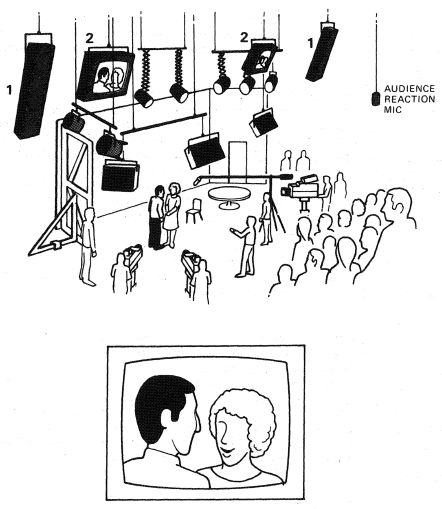The Studio Audience
Unquestionably, certain productions gain appreciably from the presence of a studio audience. Comedy shows, in particular, lose their ‘edge’ when played ‘cold’ to the camera. Even an appreciative camera crew’s, reactions can help.
Controlling the audience
Various audience conventions have evolved. At concerts, – for example, we expect our audience to be silent except for subsequent applause, hopefully not coughing, fidgeting, or reacting audibly. In ‘situation, comedy’ shows (comedy action in realistic settings) we want to hearths audience laughing and clapping throughout, but not whistling or giving inaudible smiles. They are not seen on camera, though, for this would disrupt the ‘real-life’ presentation.
Because long laughter can slow, down the show, upsetting timing, the FM diplomatically but firmly encourages.and terminates audience reactions. He, or the director, has explained this need during the welcoming warm-up before the show with smiles, jokes, or other encouragement.
Some studios use applause signs. Others introduce recorded applause, usually during editing/dubbing sessions afterwards, to augment or substitute for the audience. Directors argue that although recordings may seem unethical, and often sound phoney, at least they are controllable!
Effect on performers
Some directors contend that talent can time their laughs and business better to a studio audience but others feel that the tempo slows, relative to the home viewers’ more rapid reactions. When talent is unused to TV work, they are more inclined to ‘address’ the audience, or use a ‘stagey’ delivery, instead of the more confidential, intimate approach that is more suitable for TV.
We may find our studio audience reacting to events that the camera is not yet showing (a clown awaiting his entrance). This can-puzzle and frustrate the home viewer. Studio audiences are also liable to over-react, due to group enthusiasm, determination to enjoy themselves, and a rather less critical attitude than the isolated viewer.
Accommodating the audience
As well as providing comfortable, safe seating, we must ensure that our audience can see the studio action clearly. So sets have to be arranged facing them, slung picture monitors and loudspeakers helping them follow the television treatment.
When audiences actually participate in the show, cameramen normally offer reaction shots, that the director intercuts with the front-of-camera (or on-camera) material. But if people see themselves on monitors, we must be prepared for giggles, and shy and extrovert behavior. Self-consciousness ruins reaction shots.
Studio audience viewpoint
The studio audience watches a performance under intriguingly unfamiliar conditions, with distracting mechanics all round. 1. Foldback loudspeaker. 2. Picture monitor. The viewer sees nothing of the behind-the-scenes activities, and is quite oblivious to them, seeing only a naturalistic, ‘real-life’ situation. The various floor operations (e.g. close cameras) should not obscure the action from the studio audience.

